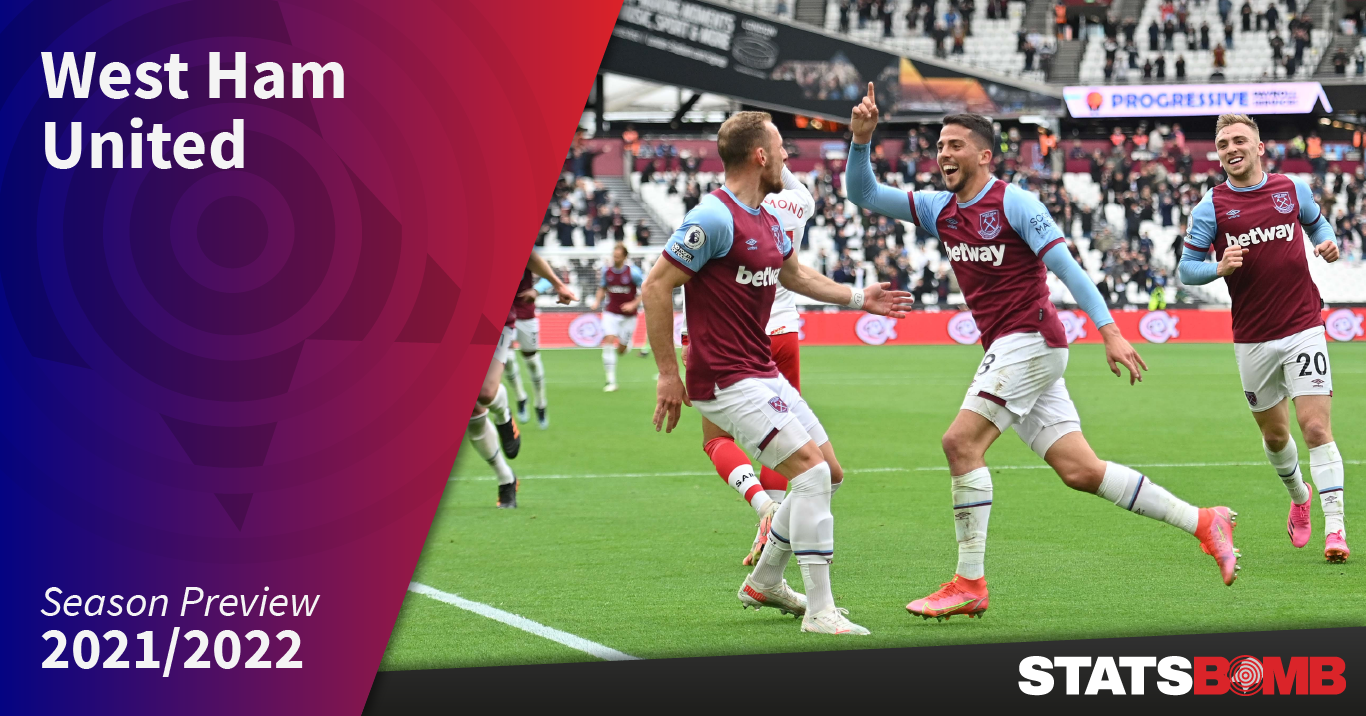To move West Ham from 16th place in 2019-20 to 6th in 2020-21 has to rank alongside any of David Moyes' career achievements. His return to the club 18 months after leaving in the summer of 2018 was not greeted with great positivity, and it appeared to take the enforced pandemic shutdown to get the ship steering in the right direction. However, few teams can be seen to have benefited so greatly from playing in the current climate, and the way the club has evolved and improved in Moyes' tenure is a ringing endorsement towards the elusive attribute every manager would like--time.
That 26 point season-on-season improvement ranks third behind Leicester 2015-16 and Chelsea 2016-17 across the Premier League era:
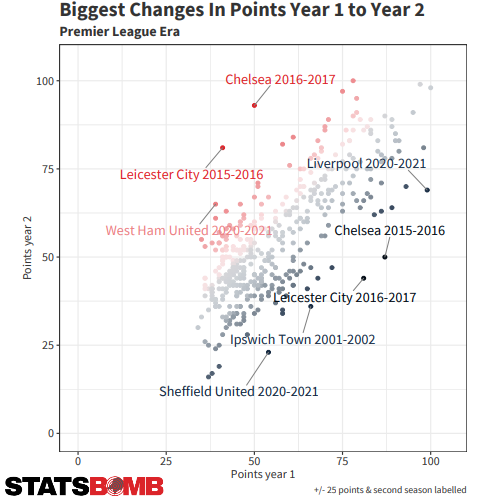
It was no fluke either and is reflected in the shot metrics that powered the team:
- non-penalty xG rose from 1.14 to 1.34 per game
- non-penalty xG conceded declined from 1.49 to 1.17 per game
- ...causing xG to go from -0.35 per game to +0.17; half a goal gains are not to be undervalued, this team improved substantially
- they took more clear shots (1.5 up to 1.9 per game)
- they conceded fewer clear shots (2.6 down to 1.9 per game)
- the chopped a load off their set piece shot concessions (down from 3.4 to 2.6 per game, xG here halved from 0.31 to 0.17 per game)
...while stylistic play features were clear too:
- 32% of box entries were via a cross (most in league)
- led the league for metrics relating to pace and directness
- second lowest passes per defensive action
- least counterpressures and resultant regains
- closest shot distance (both non-penalty and open play)
This all paints a picture of an organised, somewhat reactive and patient team. They also knew which games represented their best chance of success. Eventual top four? A 0-1-7 WDL record. Rest of the league? A stellar19-7-4 record.
We discussed the role of long carries and shots and goals from defensive regains in last year's preview and these features generally persisted. West Ham kept their shape and waited for opportunities to break forward. Once they did they created chances at a decent volume for their key contributors, once more Michail Antonio benefited but also a resurgent Jesse Lingard:
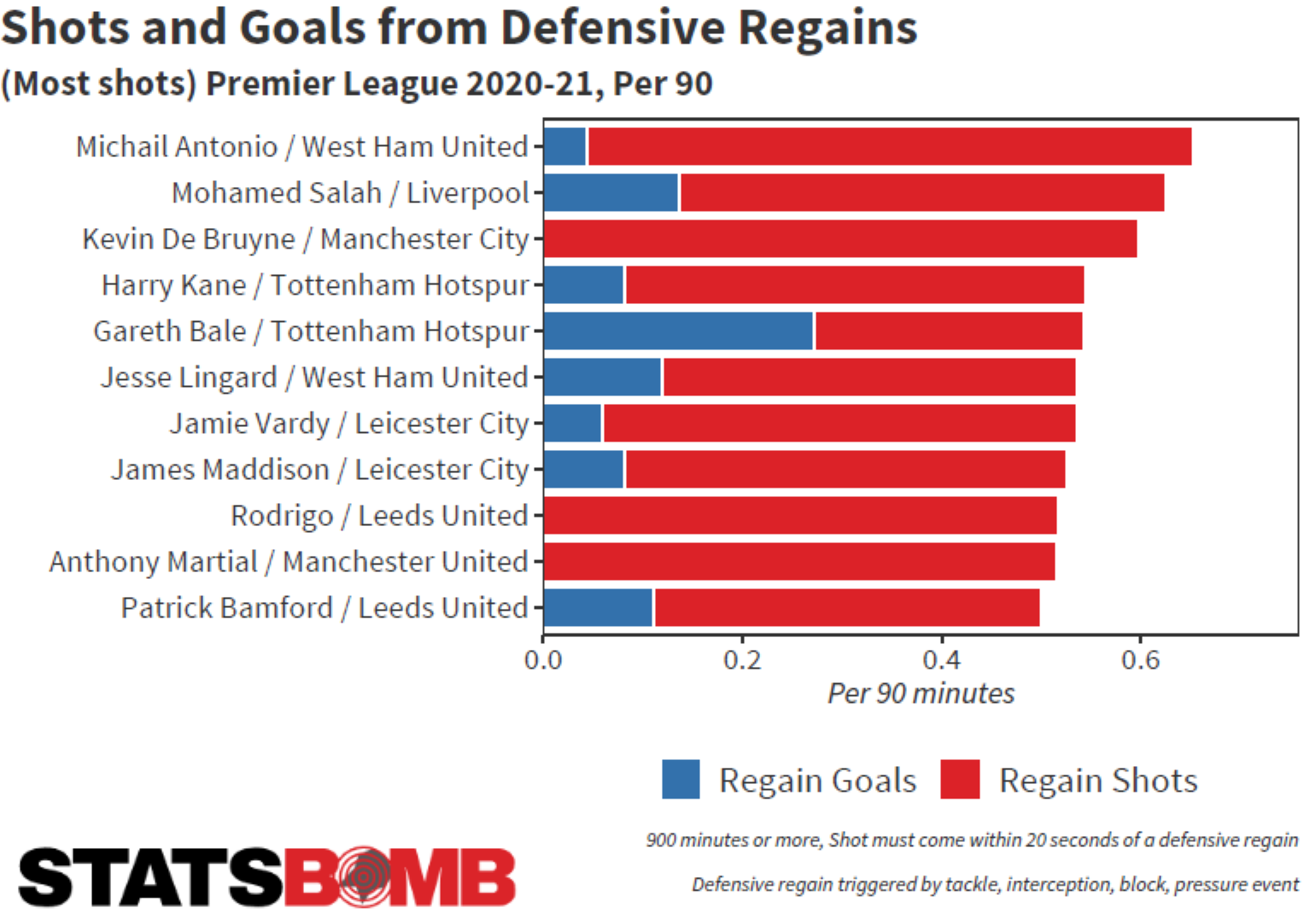
The boost that Lingard brought to the back half of West Ham's campaign was both large and perhaps unexpected. Lingard, a player who has been noted to steer under his expected goals values in the past, scored eight non-penalty goals from an xG of around four to force his way all the way back into the England squad.It appears likely that he will be staying in Manchester this season and for West Ham losing not just the player but one in the form of his life is a significant blow.
As yet, the Hammers have been slow to enter the transfer market, with the main change from the start of last season the removal of their highly priced bench men. Sebastian Haller left for Ajax in the winter and Felipe Anderson was practically given away in a cheap deal to take him to Lazio. Neither convinced for West Ham in the aggregate and quickly fell down the pecking order under Moyes, but their removal, alongside that of Lingard, does leave something of a lack of depth in attacking positions. In general Moyes operated a small squad in 2020-21, and he talked about how he instilled an effective group ethos during difficult times in a column for the Times ahead of the Euros:
"At West Ham, during the club season, I made a conscious effort to make training more fun...to not keep it so heavy. I thought about the world the players were having to live in, there was no opportunity for them to leave the bubble (so) we had to make sure they came into work and felt they were with their friends. Footballers were challenged by lockdowns and the lack of "normal" life and found they were happy to get out of the house, pleased to be in training, and craved it from the point of view of structure and routine. So there was actually more training -- but we made sure that many days there were lighter training loads. (In general) unity and spirit helped "smaller" clubs navigate the difficult conditions and do well in many of the domestic leagues."
What has been ahead of and during this summer done is limited; Craig Dawson's loan was converted to a permanent deal back in April and Alphonse Areola recently arrived on loan from PSG after a solid season in London at Fulham:
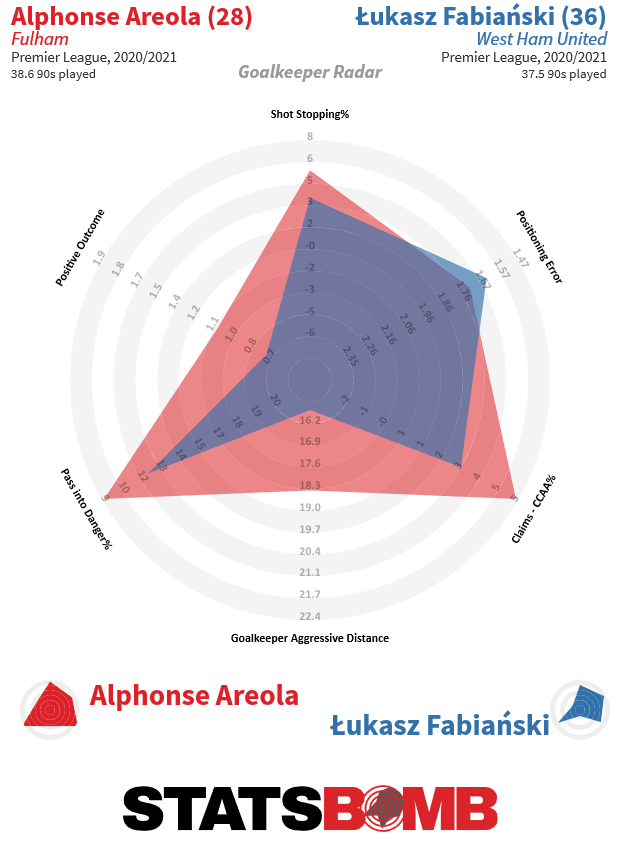
With Fabiański now 36 years old, it makes sense to start thinking about succession and we will see who Moyes puts his faith in from week one. Areola is a more active and "modern" goalkeeper than Fabiański, but the Polish veteran has done little wrong in his West Ham tenure and may well see the position still as his own.
Warning Signs?
One of the hallmarks of Moyes' second spell has been his consistency in selection. In 2020-21, eight players played in more than 70% of the team's minutes and the core group he has relied upon is small. When Antonio missed time in the autumn of 2020, Haller stepped in, but there are a further string of players who look core--perhaps Declan Rice, Aaron Cresswell, Tomáš Souček and Vladimír Coufal. The team avoided injury problems last season and that consistency in selection looked to work to West Ham's benefit.
The main selection choices week to week look likely to be in the attacking midfield band. Jarrod Bowen, Manuel Lanzini, Pablo Fornals are all in the mix but could Saïd Benrahma's second season see better returns and omit the need to replace Lingard in the market?
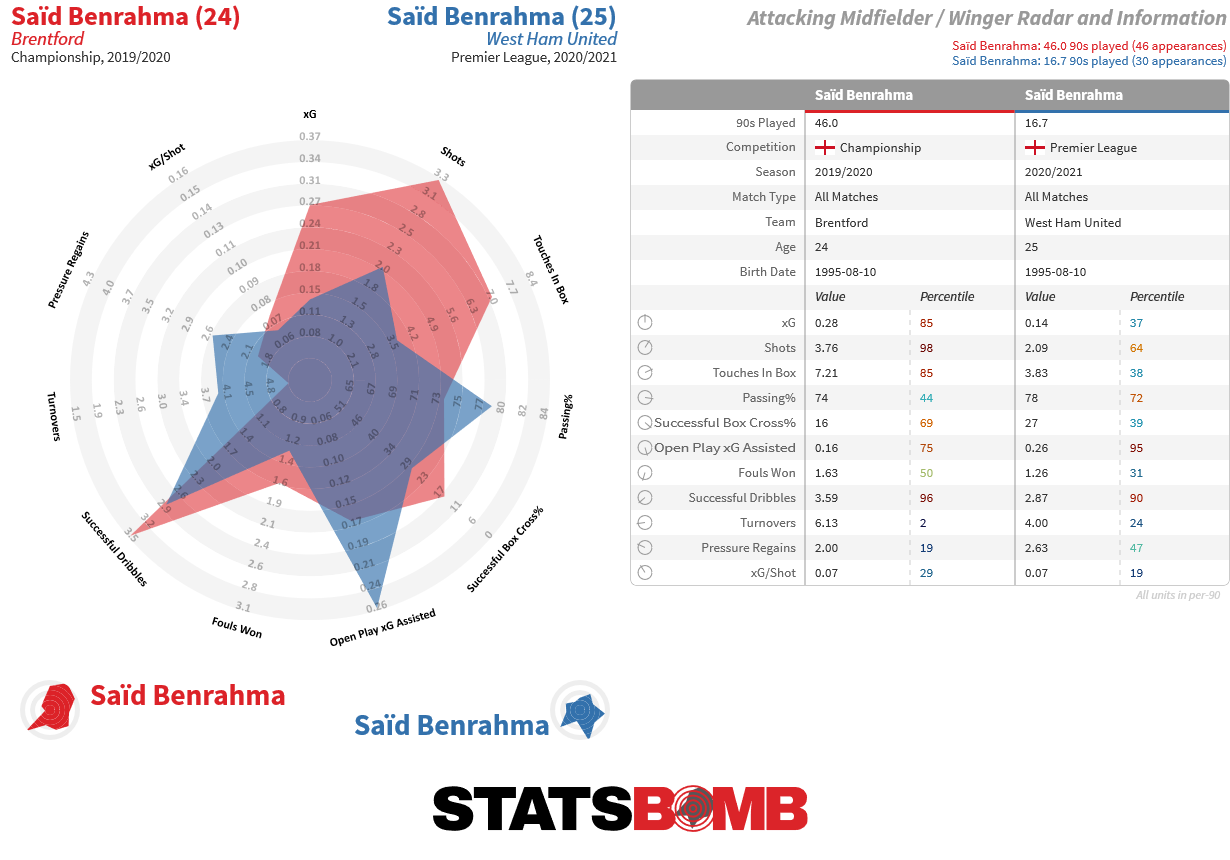
He saw a lot of bench time in Premier League season one, and the variation of his profile compared to his time at Brentford was stark. Gone was the shot-happy drifting left-sided attacker, replaced by a more shot-shy, creative player fitting in across the attacking band. He was in competition with Pablo Fornals for a left-sided slot then Lingard became the key man in the centre and Benrahma never quite nailed down the starting space. It would be no surprise if Moyes values positional discipline and Benrahma doesn't quite offer exactly what he wants from his wide attackers, but he's certainly talented enough to come forward and contribute more, if empowered.
Setting realistic expectations for West Ham's season means without further investment, a replication of anything approaching last season's 65 points would represent the absolute best outcome this group could expect, and doing so, even from similarly small net positive metrics is fairly unlikely. There's also a hidden drift in the end of season form to note:
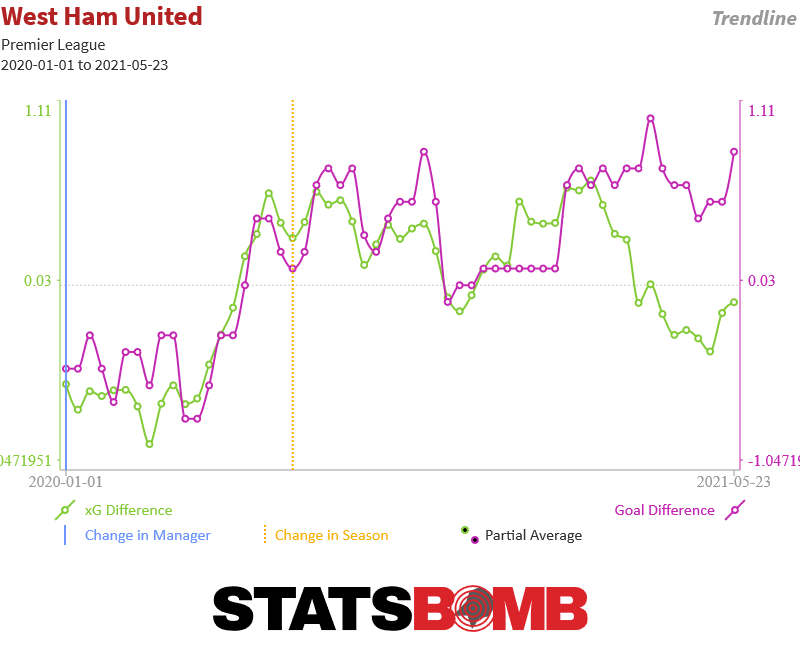
Throughout Moyes' tenure, West Ham's xG and goal differences have tracked fairly reliably. This is no given, and we can see divergence at the end of 2020-21, in which goal difference persisted significantly ahead of xG. Now, that was great to keep the results coming as the summer beckoned, but is less encouraging ahead of the new season; West Ham were at their worst in 2020-21 at season's end.
Where will West Ham end up? Bookmakers are currently projecting a firm mid-table finish and around 50 points and while that may seem slightly ungenerous, it's not hard to toss around their metrics, quietness in the transfer market and risk profile towards squad depth versus key injuries and feel that is in range. The coming month and transfers could move the needle here though and I'd probably have them good for a couple more wins than that, particularly if they acquire a useful back-up or alternative to Antonio.
2020-21 was a season in which the unique circumstances of low pressing pandemic-ball and a stable first team helped Moyes extract the best from a group of players that played with a clear identity. With crowds back in stadiums, it's hard to imagine that the slightly neutral aspect of 2020-21 will persist and some of the benefits accrued from a more passive strategic style may well decline. That does not mean that West Ham's future prognosis is particularly worrying, just that a small detour down into mid-table is the most likely outcome. This would still represent a huge overall improvement on what Moyes inherited and justify his retention, with a view to continuing to build and sustain within the league comfortably. To move upwards or match 2020-21 will probably take both more time and significant investment, and having been bitten by high-priced flops such as Haller and Anderson, West Ham's ownership may be content to swim in shallower transfer waters for now too.
Last season I felt that transfer backing could be the difference between lower mid-table security and something slightly more than that, and the equation is probably similar. Again West Ham have a choice to make, but this time they are making it from a higher vantage point, that of safety.
Want to read about another team? The rest of our Premier League season previews can be found here If you're a club, media or gambling entity and want to know more about what StatsBomb can do for you, please contact us at Sales@StatsBomb.com We also provide education in this area, so if this taste of football analytics sparked interest, check out our Introduction to Football Analytics course Follow us on Twitter in English and Spanish and also on LinkedIn
